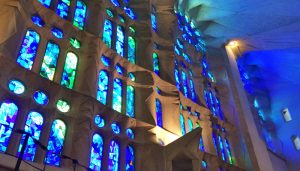Sagrada Familia: History Under Construction
By Michele Reed
michele@cny55.com
Photos by Bill Reed
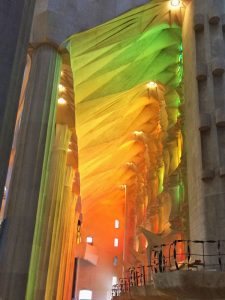
Often, as we wander in France and Spain, exploring castles, cathedrals and chateaus, we feel like time-travelers, marveling at the architecture of some far-off historical era.
But sometimes, we are lucky enough to come upon history in the making. The closest we have come to witnessing the actual construction of a European cathedral, which in the Middle Ages would have taken hundreds of years, is the Basilica of the Sagrada Familia, or Holy Family, in Barcelona.
True to the medieval tradition, the giant house of worship has been under construction for more than 100 years and is still under way. Completion is estimated for 2026, the centennial of its architect’s death.
Looking like a giant sandcastle looming over the city of Barcelona, Sagrada Familia’s four facades depict events from the life of Christ. The first time we visited in 2013, only two facades were completed, those showing Jesus’ birth and death. We could see cranes and scaffolding on the other two sides, as workmen, much like the medieval stonecutters, carved figures of angels, saints and animals, into the surface of the other two façades.
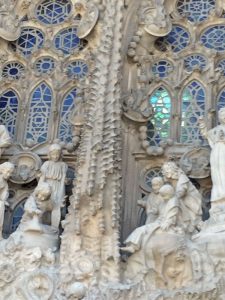
This magnificent cathedral was designed by the great Modernista architect, Antoni Gaudi, beginning in 1883. Although he started building it in a traditional style, he soon changed direction to the soaring, modern structure we see today. The foundations of the Nativity Façade, depicting the birth of Christ, were laid in 1892. When you look at the figures, it’s hard to imagine they were designed more than 120 years ago.
It’s even harder to imagine this structure as dating back to the 19th century, when you see the wildly colored stained-glass windows, their religious subjects depicted in sharp, geometric shapes. Gaudi designed the interior like a magnificent undersea world, with shell-shaped vessels, and walls that ripple like waves of the Mediterranean, a stone’s throw away. When the light comes through the stained glass, depending on the time of day, ripples of green, blue, yellow and red fill the interior and the wavy walls amplify the effect of being under the sea.
It’s easy to get mesmerized, staring at the shimmering ripples of color, but turn a corner, and you see your way blocked, by yet more scaffolding, as artisans apply finishing details to a chapel, window or wall.
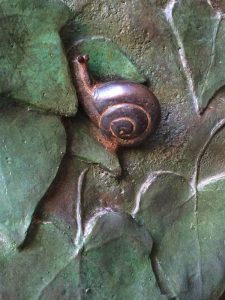
An avid hiker in the Pyrenees Mountains near Barcelona, Gaudi took his inspiration from nature. Sagrada Familia is an exuberant explosion of leaves, animals, bugs and birds. The massive doors are cast in bronze and amid a profusion of leaves lurk frogs, snails, worms and insects.
Gaudi was already famous before taking on the job of designing Sagrada Familia, having built the city’s massive Park Guell for a wealthy industrialist and homes for many of Barcelona’s most prominent citizens. But once he became architect of the basilica, it is safe to say that he devoted the rest of his life to this masterwork. He built himself a little studio and living space attached to the cathedral. There, he drew up the plans and supervised the workmen who carried them out.
In 1925, he saw the first of the temple’s four towers completed. Only six months later, Gaudi died after he was hit by a streetcar in downtown Barcelona in 1926, but work continued on the cathedral, according to his plans. Now more than a century after Gaudi began his masterpiece, it is finally nearing completion, estimated to be finished within the next decade.
In the basement of the church is a tiny museum, with reproductions of Gaudi’s workspace and the sleeping alcove he occupied while overseeing the building of the structure. The architect’s sketches are on display, along with the intricate string-and-weight models he built to simulate – upside down – the vaulted arches of the cathedral.
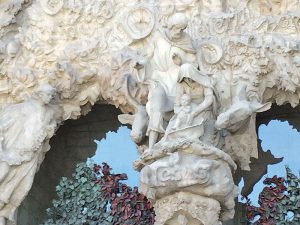
We left Sagrada Familia awed by the work and dedication which is still going into this piece of living history and ongoing massive construction project. We also took with us a sense of what it must have been like to be medieval people watching the construction of those great European cathedrals we love to explore.
